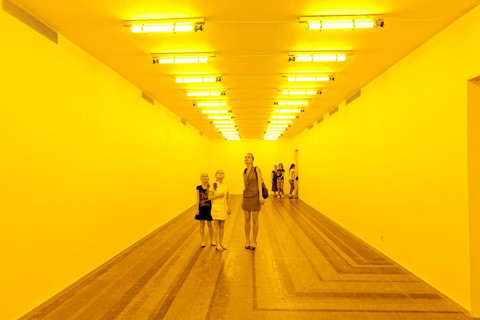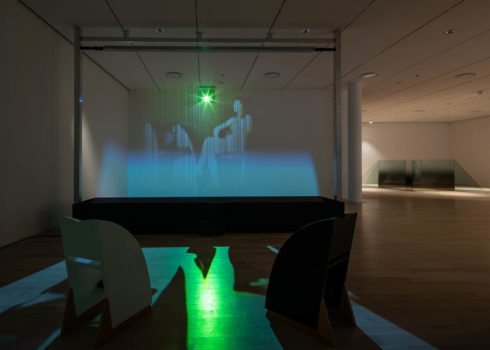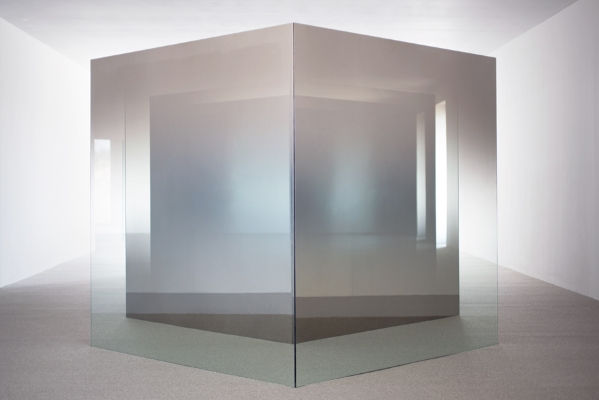Installations of Light
- hacerestrago
- Mar 1, 2021
- 4 min read
Updated: Mar 2, 2021
In preparing this feature, one of our team members recalled the sculpture studio at their university in which the gallery/critique room featured 3 dramatic skylights in the vaulted space. While this provided a wash of natural light over the staggered plinths, it eliminated any opportunity for the incorporation of directed light and deliberate shadow into the sculptures. This, not surprisingly, proved to be an immediate and almost inexcusable loss as light has the power to transform any artwork, any space, and any experience.
With this power in mind, let us introduce you to four incredible sculptures and installations that masterfully utilize light to transform the experiences of viewers.
In our humble opinion, few conversations on the use of light in art are complete without a prominent discussion of Dan Flavin. Flavin transformed gallery walls and corners by strategically placing florescent light bars into organized neon arrangements of staggering color. We love his Corridor installations that block off doorways to other rooms using florescent bulb bars to form deceiving curtains of light that lure us in like the bead curtains of Felix Gonzalez-Torres without the possibly of advancing through them.
In all his works, Flavin awakened otherwise darkened galleries by illuminating them with dramatic color that playfully framed and reflected against stark white walls. Because of their orientation, many of the pieces don't produce visual shadows off of the viewers, creating fully independent light sources that have little interaction with the audience—aside from serious pupil constriction!
In direct contrast to Flavin’s works is Olafur Eliasson’s Room for One Color. The Icelandic Artist lines the ceilings of rooms with golden yellow florescent lights that shower pedestrians in a dramatic glow of stark lemon shade. What makes these installations so impactful is the transformation that occurs in the presence of yellow light: the eye perceives everything within the space as black and white. That means every face, handbag, and fly away hair is immediately desaturated, standing in impressive contrast to the vivid yellow surrounds. The experience is highly cinematic, and, frankly, a little trippy!
Larry Bell’s Black Room is equally disorienting, although, it probably wouldn’t translate well on film. The installation consists of a maze in complete and total darkness that a viewer navigates by keeping one hand along the wall at all times to guide them along the perimeter of the winding corridor. The complete absence of light is delicious. To add a moment of unexpectedness, at the far end of the maze, elevated to the ceiling and tucked slightly behind the wall is a yellow florescent light that casts just the slightest glow. As you slowly make your way toward it, you feel almost like a moth to a light, curious and eager to explore outside the suffocating darkness. Much like Eliasson’s spaces, the light creates an experience of living in black and white, although we weren’t very perceptive of this as we were so focused on maintaining our sanity in the darkness! It’s a bit frightful to then move away from the light, back into the weighted dark, but it’s literally an eye opening moment when you reemerge into the jarring light of the main gallery space. (We couldn't capture an image worth sharing of the pitch black Black Room so here are a few of Bell's glass installations as well as an installation he created that projected video onto a curtain of falling water that all magnificently filter, capture, and warp light!)
Finally we introduce Doug Wheeler. Wheeler creates experiential exhibitions and installations that never fail to leave us weak at the knees. His recent installation at David Zwirner Gallery in Chelsea did not disappoint, nor did we expected it to! Illuminating the perimeter of thin fabric stretched taught along the walls of the gallery, Wheeler worked to capture the luminosity of a blue sky as viewed from an airplane. Zwirner writes on the piece, “Wheeler alters the traditionally static viewing experience of a work of art, thereby destabilizing our innate sense of equilibrium and imparting the feeling of moving with the earth towards an unreachable horizon.” and we frankly cant agree more. It is peacefully destabilizing. While Bell’s Dark Room left us a bit shaken by discomfort, Wheeler entices us with an addictively and hypnotically minimalist space. In front of the illuminated wall, you want to stare endlessly. It’s truly mesmerizing. Whether the result of the hypnotic color pallet or the effortless symmetry, it’s a stunning experience with light that feels profound.
There are no shortage of contemporary art installations that capture and manipulate light and we urge you to explore them in person! The interactive beams from Anthony McCall, glaring lasers from Rita McBride, lightening strikes from Walter De Maria, and even the resoundingly reflective sculptures from Anish Kapoor all utilize the gravity, power, hypnotism, and fragility of light to create uniquely transformative and moving works of art. The next time you venture into a museum or gallery, take a moment to consider the surrounding light and shadow! There is a profound psychological and emotional relationship to the presence and absence of light that works in perfect harmony with the expressivity of art to create something truly magical.



































